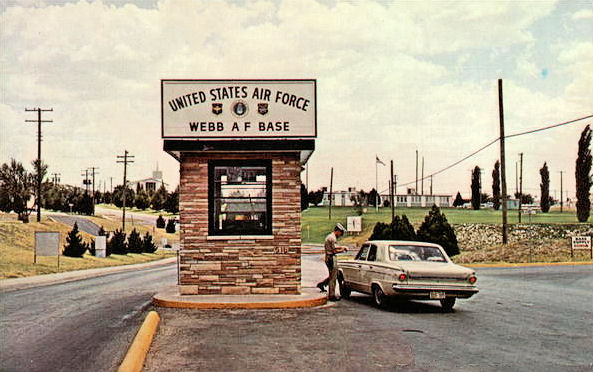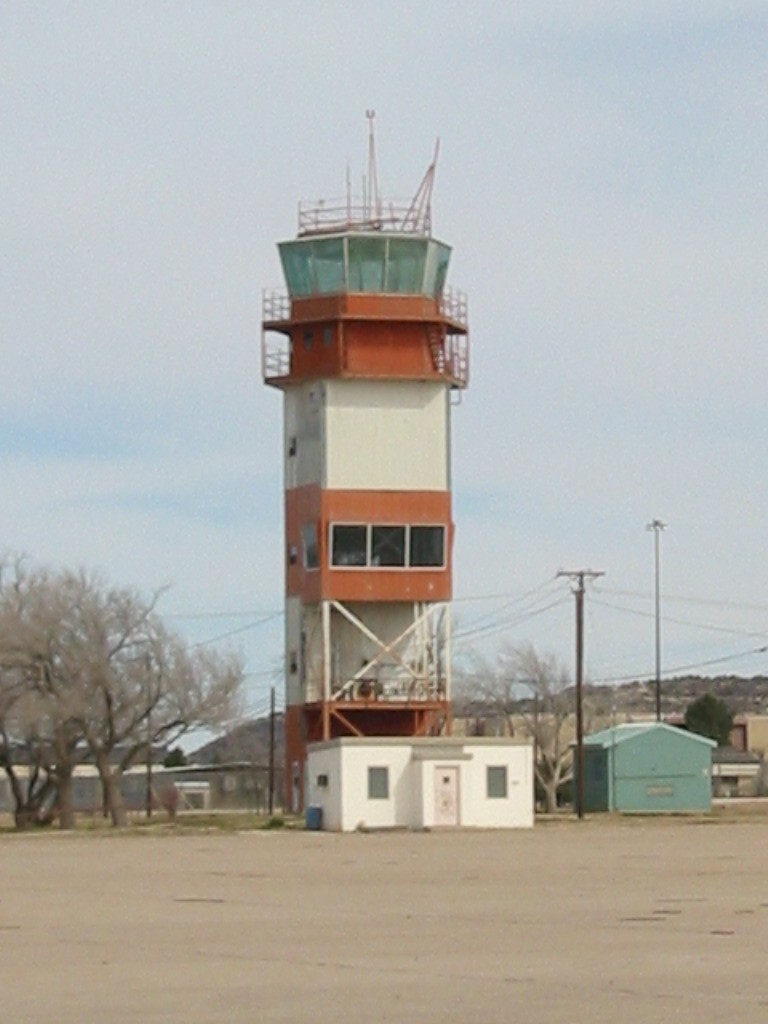Webb AFB on:
[Wikipedia]
[Google]
[Amazon]
Webb Air Force Base , previously named Big Spring Air Force Base, was a

 The facility first was used by the
The facility first was used by the

 The facility was brought back into service as a primary training installation because of the
The facility was brought back into service as a primary training installation because of the
 By the mid-1970s, the end of the Vietnam War, the associated financial costs of that conflict and related cuts in USAF force structure and future defense budgets meant a marked decrease in the need for Air Force pilots. One of the major issues facing the ATC commander and his staff during 1976 was the prospect of closing two UPT bases. Rather than reduce training production at all seven locations, ATC officials believed it to be more economical to close two bases. So it was on 11 March 1976 that the Secretary of the Air Force proposed closing several military installations, to include UPT bases
By the mid-1970s, the end of the Vietnam War, the associated financial costs of that conflict and related cuts in USAF force structure and future defense budgets meant a marked decrease in the need for Air Force pilots. One of the major issues facing the ATC commander and his staff during 1976 was the prospect of closing two UPT bases. Rather than reduce training production at all seven locations, ATC officials believed it to be more economical to close two bases. So it was on 11 March 1976 that the Secretary of the Air Force proposed closing several military installations, to include UPT bases
File:AAF Bombardier School Big Spring AAF TX.png, Emblem of the AAF Bombardier School Big Spring AAF
File:3560th Pilot Training Wing - Emblem.jpg, 3560th Pilot Training Wing
File:331st Fighter-Interceptor Squadron - Emblem.jpg, 331st Fighter-Interceptor Squadron
File:78th Flying Training Wing - Emblem.jpg, 78th Flying Training Wing
Big Spring Flying School Class 43-06, Big Spring Flying School Yearbook
Through the Crosshairs Class 43-11, Advanced Bombardier School, Big Spring, Texas Yearbook
Gyro, The Class 43-18, Big Spring Army Air Field Yearbook
*
History of the 45th Fighter Squadron.
Hangar 25 Air Museum official website
{{Authority control 1942 establishments in Texas Airports established in 1942 Buildings and structures in Howard County, Texas Installations of the United States Air Force in Texas Military installations closed in 1977 Defunct airports in Texas Airports in Texas 1977 disestablishments in Texas
United States Air Force
The United States Air Force (USAF) is the air service branch of the United States Armed Forces, and is one of the eight uniformed services of the United States. Originally created on 1 August 1907, as a part of the United States Army Si ...
facility of the Air Training Command
Air Training Command (ATC) is a former United States Air Force (USAF) Major Command designation. It was headquartered at Randolph Air Force Base, Texas, but was initially formed at Barksdale Air Force Base, Louisiana. It was re-designated as ...
that operated from 1951 to 1977 in West Texas
West Texas is a loosely defined region in the U.S. state of Texas, generally encompassing the arid and semiarid lands west of a line drawn between the cities of Wichita Falls, Abilene, and Del Rio.
No consensus exists on the boundary betw ...
within the current city limits of Big Spring. Webb AFB was a major undergraduate pilot training (UPT) facility for the Air Force, and by 1969, almost 9,000 pilots had been trained at Webb. The last operational wing at Webb AFB was the 78th Flying Training Wing.
History
World War II

 The facility first was used by the
The facility first was used by the United States Army Air Forces
The United States Army Air Forces (USAAF or AAF) was the major land-based aerial warfare service component of the United States Army and ''de facto'' aerial warfare service branch of the United States during and immediately after World War II ...
as Big Spring Army Air Field, opening on 28 April 1942 as part of the Central Flying Training Command.
Activated on 26 June 1942, the mission of Big Spring AAF was to train aviation cadets in high-altitude precision bombing as bombardiers. It was one of the "West Texas Bombardier Quadrangle" schools of the Army Air Forces Training Command. The other bases in the quad were Midland Army Airfield
Midland Army Airfield is a former World War II military airfield, located 8.4 miles west-southwest of Midland, Texas. It operated as a Bombardier training school for the United States Army Air Forces from 1942 until 1945.
History
Origins
M ...
, San Angelo Army Airfield
San Angelo Army Airfield is an inactive United States Air Force base, about 8 miles south-southwest of San Angelo, Texas. It was active during World War II as a training airfield. It was closed on 30 November 1945.
History
Initially built as ...
, and Childress Army Airfield.
Construction of the Army Air Forces Bombardier School began on 15 May 1942, and the airfield received its first class of cadets (118 men) on 16 September 1942. The 79th Bombardier Training Group was the USAAF instructional unit at Big Spring AAF; the 365th Base Hq and Air Base Squadron maintained the station and commanded the ground support units. Operational squadrons under the 78th BTG were:
* 812nd Bombardier Training Squadron
* 815th Bombardier Training Squadron
* 816th Bombardier Training Squadron
* 817th Bombardier Training Squadron
The base was declared surplus and was turned over to the War Assets Administration after being closed. It eventually reverted to city control, and it served as the Big Spring Municipal Airport for six years.
Cold War
The airfield was reactivated as Big Spring Air Force Base on 1 October 1951 by the United States Air Force for theAir Training Command
Air Training Command (ATC) is a former United States Air Force (USAF) Major Command designation. It was headquartered at Randolph Air Force Base, Texas, but was initially formed at Barksdale Air Force Base, Louisiana. It was re-designated as ...
(ATC) which established the 3560th Pilot Training Wing (Advanced Single-Engine). However, the command was not formally able to operationally activate the base until 1 January 1952 because the City of Big Spring had difficulty acquiring clear title to some of the property it intended to transfer to ATC

 The facility was brought back into service as a primary training installation because of the
The facility was brought back into service as a primary training installation because of the Korean War
{{Infobox military conflict
, conflict = Korean War
, partof = the Cold War and the Korean conflict
, image = Korean War Montage 2.png
, image_size = 300px
, caption = Clockwise from top:{ ...
and the need for additional pilots. Four months later, on 18 May 1952, ATC changed the name of Big Spring to Webb Air Force Base to memorialize 1st Lieutenant James L. Webb, a Big Spring native and World War II combat pilot in Europe, who was killed in a mishap off the Japanese coast flying a P-51 Mustang
The North American Aviation P-51 Mustang is an American long-range, single-seat fighter and fighter-bomber used during World War II and the Korean War, among other conflicts. The Mustang was designed in April 1940 by a team headed by James ...
in 1949 during a training mission.
Instruction of the first class began in April 1952. The initial mission of the 3560th PTW was basic, single-engine flight training. The wing was equipped with 37 T-28 Trojan
The North American Aviation T-28 Trojan is a radial-engine military trainer aircraft manufactured by North American Aviation and used by the United States Air Force and United States Navy beginning in the 1950s. Besides its use as a trainer, ...
propeller and 28 T-33 Shooting Star
The Lockheed T-33 Shooting Star (or T-Bird) is an American subsonic jet trainer. It was produced by Lockheed and made its first flight in 1948. The T-33 was developed from the Lockheed P-80/F-80 starting as TP-80C/TF-80C in development, then d ...
jet trainers. The base population soon passed 2,000. With the end of the Korean War, in 1954 ATC reduced its basic single-engine pilot schools from seven to five, this saw the number of students at Webb remain basically the same as the number of new pilots needed was reduced. The propeller-driven T-28 was phased out in 1956 and converted all training to the jet-powered T-33.
In 1956, the Air Defense Command
Aerospace Defense Command was a major command of the United States Air Force, responsible for continental air defense. It was activated in 1968 and disbanded in 1980. Its predecessor, Air Defense Command, was established in 1946, briefly inac ...
's 331st Fighter-Interceptor Squadron
The 331st Fighter-Interceptor Squadron is an inactive United States Air Force unit. Its last assignment was with Air Defense Command at Webb Air Force Base, Texas, where it was inactivated on 1 March 1967.
During World War II the squadron was a ...
was transferred to Webb AFB from Stewart AFB, New York to defend the southern United States border on air intercept missions as part of the Central Air Defense Force
The Central Air Defense Force (CADF) is an inactive United States Air Force organization. Its last assignment was with Air Defense Command being stationed at Richards-Gebaur Air Force Base, Missouri. It was inactivated on July 1, 1960.
History
...
. Originally flying the F-86D Sabre
The North American F-86D/K/L Sabre (initially known as the YF-95 and widely known informally as the "Sabre Dog",) was an American transonic jet fighter aircraft. Developed for the United States Air Force in the late 1940s, it was an interceptor ...
, the squadron upgraded to the F-102 Delta Dagger
The Convair F-102 Delta Dagger was an American interceptor aircraft designed and manufactured by Convair.
Built as part of the backbone of the United States Air Force's air defenses in the late 1950s, it entered service in 1956. Its main purpo ...
in 1960, then transitioned to the F-104 Starfighter
The Lockheed F-104 Starfighter is an American single-engine, supersonic air superiority fighter which was extensively deployed as a fighter-bomber during the Cold War. Created as a day fighter by Lockheed as one of the " Century Series" of ...
in 1963. In March 1967, the 331st was redesignated the 4760th Combat Crew Training Squadron and charged with training Royal Jordanian Air Force
The Royal Jordanian Air Force (RJAF; ar, سلاح الجو الملكي الأردني, Silāḥ ul-Jawu al-Malakī 'al-Urdunī) is the aerial warfare branch of the Jordanian Armed Forces.
History
Early days
Jordan gained independence in 1 ...
students on F-104s. It was inactivated on 1 October 1967 when the Jordanians were recalled because of the war with Israel in the summer of 1967.
Closure
Craig AFB
Craig Air Force Base near Selma, Alabama, was a U.S. Air Force undergraduate pilot training (UPT) installation that closed in 1977. Today the facility is a civilian airport known as Craig Field Airport and Industrial Complex (ICAO: KSEM; FAA: SE ...
, Alabama, and Webb AFB, Texas.
At Webb AFB, the last two pilot training classes completed course work on 30 August 1977, and fixed wing qualification training ended on 1 September 1977. Air Training Command inactivated the 78th Flying Training Wing at Webb AFB on 30 September 1977, although the 78 FTW was subsequently reactivated as the 78th Air Base Wing (78 ABW) at Robins AFB, Georgia, a role it continues in today. The two installations, Webb and Craig were placed in caretaker status the following day. The training previously provided by Webb AFB was moved to Sheppard AFB, Texas, where the first class began on 30 June in what would eventually become Euro-NATO Joint Jet Pilot Training (ENJJPT).
Webb AFB was turned over to the General Services Aministration for disposal on 1 January 1978 and the property later turned over to the Big Spring Industrial Park.
The airfield and flight line was converted to an uncontrolled/UNICOM
A UNICOM (universal communications) station is an air-ground communication facility operated by a non-air traffic control private agency to provide advisory service at uncontrolled aerodromes and airports and to provide various non-flight services ...
-only general aviation airport renamed Big Spring McMahon-Wrinkle Airport, serving the City of Big Spring. In addition, three units of the Big Spring Correctional Center (a federal prison
A federal prison is operated under the jurisdiction of a federal government as opposed to a state or provincial body. Federal prisons are used for convicts who violated federal law (U.S., Mexico), inmates considered dangerous (Brazil), or those s ...
privately operated by Cornell Companies
Cornell Companies (NYSE:CRN) was an American corporation that operated correctional facilities, contracting them to state and local governments. The company's headquarters were located in Houston, Texas. On August 12, 2010, Cornell was acquired b ...
) are located on the base grounds (as well as FCI Big Spring, which is a separate facility and operated directly by the Federal Bureau of Prisons
The Federal Bureau of Prisons (BOP) is a United States federal law enforcement agency under the Department of Justice that is responsible for the care, custody, and control of incarcerated individuals who have committed federal crimes; that i ...
).
See also
* Texas World War II Army Airfields *34th Flying Training Wing (World War II)
The 34th Operations Group is an inactive United States Air Force unit. It was first activated as the 34th Flying Training Wing and supervised training of bombardiers and pilots for multiengine aircraftuntil it was disbanded on 16 June 1946 at ...
References
External links
Big Spring Flying School Class 43-06, Big Spring Flying School Yearbook
Through the Crosshairs Class 43-11, Advanced Bombardier School, Big Spring, Texas Yearbook
Gyro, The Class 43-18, Big Spring Army Air Field Yearbook
*
History of the 45th Fighter Squadron.
Hangar 25 Air Museum official website
{{Authority control 1942 establishments in Texas Airports established in 1942 Buildings and structures in Howard County, Texas Installations of the United States Air Force in Texas Military installations closed in 1977 Defunct airports in Texas Airports in Texas 1977 disestablishments in Texas